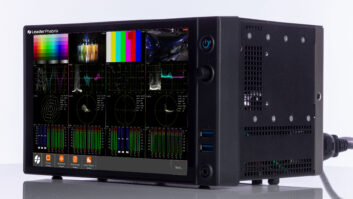If you haven’t heard of the analog sunset, the good news is you’re not alone.
Apr 11, 2012 11:47 AM,
By Tim Kridel, Special to InfoComm International
The move to digital shouldn’t catch AV pros unprepared.
If you haven’t heard of the analog sunset, the good news is you’re not alone. The bad news is ignorance won’t be bliss for AV professionals and clients alike.
“Are we aware of it as an industry? Not as much as we need to be,” says Joseph Thomas, AVI-SPL senior design engineer. “There are going to be some sudden service calls because people are going to be experiencing things differently than they’re used to.”
Here’s one example: An HD display that’s been showing 720p or 1080p video for years, one day drops to 480i for no apparent reason. The downgrade was set in motion in June 2009 as part of the Advanced Access Content System (AACS) license agreement, which aims to thwart piracy by limiting a Blu-ray disc’s or Blu-ray player’s ability to output analog video—thus the analog sunset.
Exactly how that limitation is achieved is one of the analog sunset’s many wild cards (more on that in a moment). Another is the impact. For some clients—particularly those with applications that work best at the highest resolutions—the downgrade will be not only noticeable, but unacceptable. For others, the change might provoke only some head scratching.
“Suppose you’ve got a digital video player, and you’re coming out of an analog port on it,” Thomas says. “Today, it’s outputting 1366×768 resolution, and tomorrow it outputs 480i. You’re still going to see a picture, but it’s not going to look the same. People will go around asking, ‘Does the look funny to you?’ It’s going to be one of those things that sneak up on people.”
SUNSET WITHIN A SUNSET
The AACS license requirements are a subset of a larger analog sunset, which is the ongoing migration toward all-digital AV in both the consumer and pro AV worlds. So in a sense, AACS just assigns a timeline to a phase-out that was always a matter of when rather than if.
“From our perspective, most integrators may not be focused on the analog sunset itself,” says Steve Somers, vice president of engineering at Extron, which published a primer about the transition. “Instead, they are dealing with the bigger, industry-wide migration from analog to digital systems.”
(Aside from AACS, the computer industry is another market force pushing analog toward obsolescence. AMD, Dell, Intel, Samsung, and LG are among the major IT vendors that plan to eliminate analog interfaces from all of their products starting next year.)
One AACS milestone was Dec. 31, 2010. As of that date, vendors could no longer manufacture Blu-ray players—including those built into PCs—with HD analog video outputs. The next milestone is Dec. 31, 2013, when vendors have to eliminate analog video outputs altogether. Neither milestone represents a hard deadline, because even after manufacturing stops, vendors and resellers still have inventory they can continue to sell.
After Dec. 31, 2010, Blu-ray disc manufacturers could begin embedding discs with a Digital Only Token, which disables the player’s analog output, and an Image Constrain Token, which allows analog output but at no more than 520,000 pixels per frame. Those tokens are noteworthy for installations that need to show third-party content such as movies.
The tokens also are one of the analog sunset’s many wild cards. Some recent Blu-ray titles have them, while others don’t, partly because film studios are concerned about customers getting upset when a new disc won’t play. “I bought a Disney disc earlier this summer that does disable the movie on the HD component ports,” says Eric Snider, a senior engineer at St. Louis-based Conference Technologies who also teaches an InfoComm digital video course.
The AACS analog sunset doesn’t affect cable, satellite, and telco TV set-top boxes, with one exception: Their analog outputs can be disabled for video-on-demand presentations of movies that are still in theaters.
In theory, the sunset also shouldn’t affect content that a client develops internally and thus isn’t subject to AACS. But that isn’t always the case, such as when an installation handles multiple content types.
“The content throughput will be affected by the hardware and by the HDMI licensing,” says AVI-SPL’s Thomas. “One problem we’re having on some devices is that if you ever output any restricted content, it’s very difficult to get, for example, a laptop with DisplayPort to go back to full bandwidth because it does a limitation on that. We’re learning these things as we go. These issues are never going to be a simple as a hardware solution.”
To read the full article, visit infocomm.org.










